2015 NISSAN GT-R child restraint
[x] Cancel search: child restraintPage 2 of 358
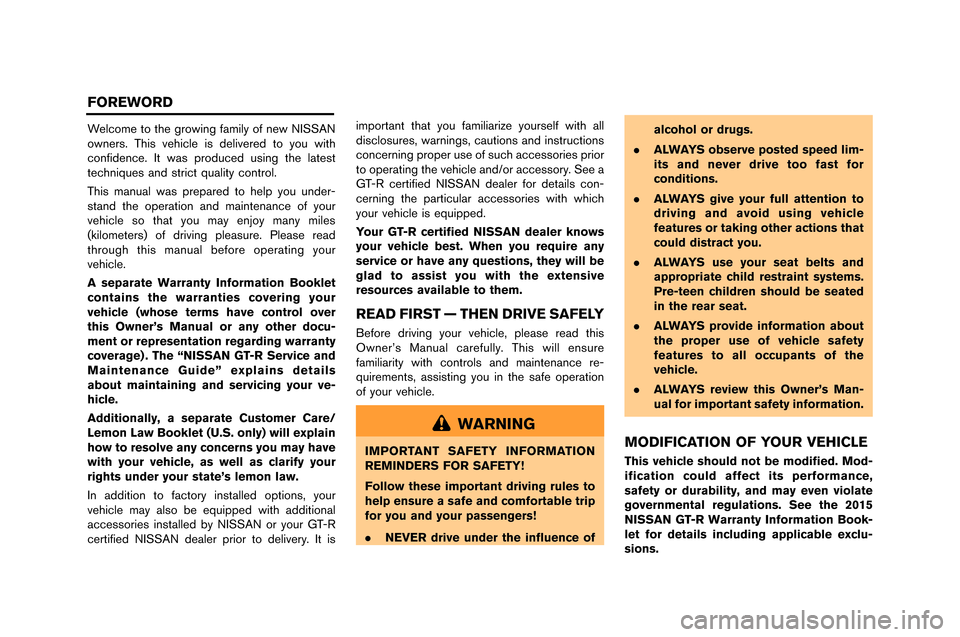
Welcome to the growing family of new NISS�fN
owners. This �behicle is deli�bered to you with
confidence. It was produced using the latest
techniques and strict quality control.
This manual was prepared to help you under-
stand the operation and maintenance of your
�behicle so that you may enjoy many miles
(kilometers) of dri�bing pleasure. Please read
through this manual before operating your
�behicle.
A separate Warranty Information Booklet
contains the warranties covering your
vehicle (whose terms have control over
this Owner’s Manual or any other docu-
ment or representation regarding warranty
coverage) . The “NISSAN GT-R Service and
Maintenance Guide” explains details
about maintaining and servicing your ve-
hicle.
Additionally, a separate Customer Care/
Lemon Law Booklet (U.S. only) will explain
how to resolve any concerns you may have
with your vehicle, as well as clarify your
rights under your state’s lemon law.
In addition to factory installed options, your
�behicle may also be equipped with additional
accessories installed by NISS�fN or your GT-R
certified NISS�fN dealer prior to deli�bery. It isimportant that you familiarize yourself with all
disclosures, warnings, cautions and instructions
concerning proper use of such accessories prior
to operating the �behicle and/or accessory. See a
GT-R certified NISS�fN dealer for details con-
cerning the particular accessories with which
your �behicle is equipped.
Your GT-R certified NISSAN dealer knows
your vehicle best. When you require any
service or have any questions, they will be
glad to assist you with the extensive
resources available to them.
READ FIRST — THEN DRIVE SAFELY
Before dri�bing your �behicle, please read this
Owner’s Manual carefully. This will ensure
familiarity with controls and maintenance re-
quirements, assisting you in the safe operation
of your �behicle.
WARNING
IMPORTANT SAFETY INFORMATION
REMINDERS FOR SAFETY!
Follow these important driving rules to
help ensure a safe and comfortable trip
for you and your passengers!
.
NEVER drive under the influence of alcohol or drugs.
. ALWAYS observe posted speed lim-
its and never drive too fast for
conditions.
. ALWAYS give your full attention to
driving and avoid using vehicle
features or taking other actions that
could distract you.
. ALWAYS use your seat belts and
appropriate child restraint systems.
Pre-teen children should be seated
in the rear seat.
. ALWAYS provide information about
the proper use of vehicle safety
features to all occupants of the
vehicle.
. ALWAYS review this Owner’s Man-
ual for important safety information.MODIFICATION OF YOUR VEHICLE
This vehicle should not be modified. Mod-
ification could affect its performance,
safety or durability, and may even violate
governmental regulations. See the 2015
NISSAN GT-R Warranty Information Book-
let for details including applicable exclu-
sions.
FOREWORD
Page 40 of 358
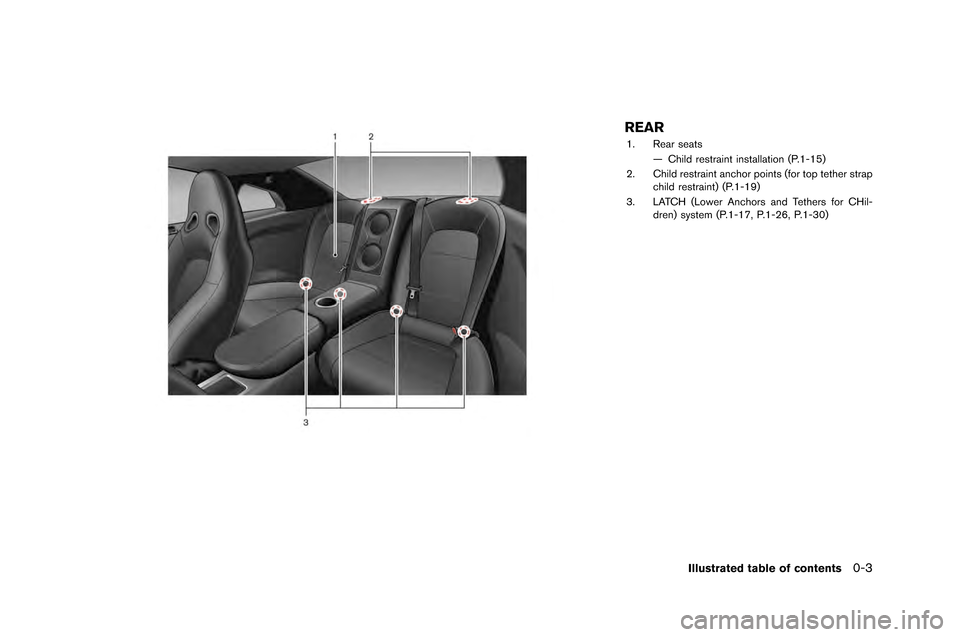
REAR
1. Rear seats— Child restraint installation (P.1-1\f)
2. Child restraint anchor \boints (for to\b tether stra\b child restraint) (P.1-19)
3. LATCH (Lower Anchors and Tethers for CHil- dren) system (P.1-17, P.1-26, P.1-30)
Illustrated table of contents0-3
Page 50 of 358
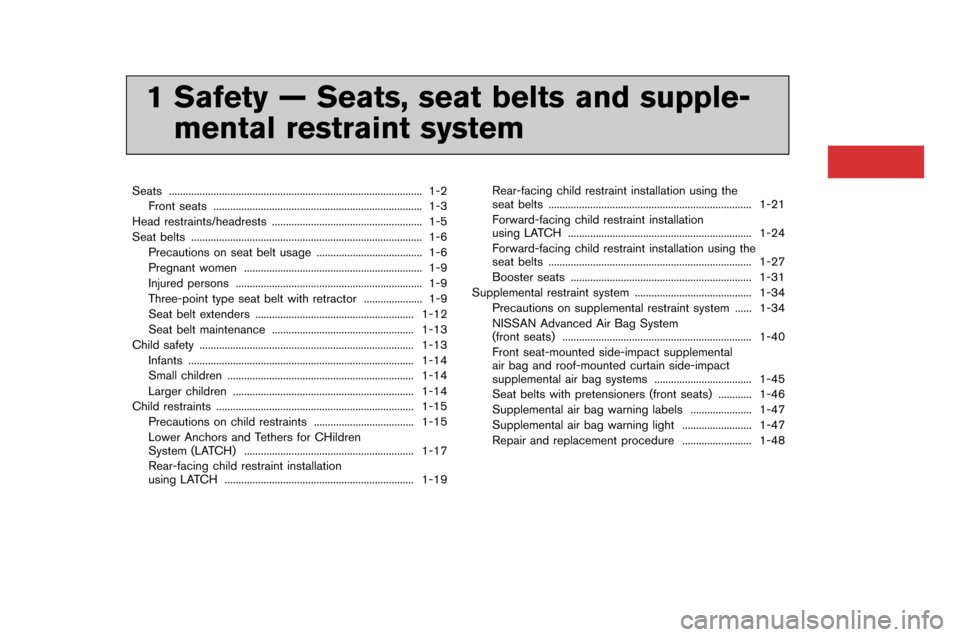
1 Safety — Seats, seat belts and supple-mental restraint system
Seats ..................�h..................�h..................�h..................�h..................�h. 1-2
Front seats ..................�h..................�h..................�h..................�h... 1-3
Head restraints/headrest�hs ..................�h..................�h..................�h 1-�f
Seat belts ..................�h..................�h..................�h..................�h........... 1-6 �brecautions on seat belt usage ..................�h..................�h.. 1-6
�bregnant women ..................�h..................�h..................�h.......... 1-9
Injured persons ..................�h..................�h..................�h............. 1-9
Three-point type seat belt with retractor ..................�h... 1-9
Seat belt extenders ..................�h..................�h..................�h... 1-12
Seat belt maintenance ..................�h..................�h............... 1-13
Child safety ..................�h..................�h..................�h..................�h..... 1-13 Infants ..................�h..................�h..................�h..................�h......... 1-14
Small children ..................�h..................�h..................�h............. 1-14
Larger children ..................�h..................�h..................�h........... 1-14
Child restraints ..................�h..................�h..................�h................. 1-1�f �brecautions on child restraints ..................�h..................�h 1-1�f
Lower Anchors and Tethers for CHildren
System (LATCH) ..................�h..................�h..................�h....... 1-17
Rear-facing child restraint installation
using LATCH ..................�h..................�h..................�h.............. 1-19 Rear-facing child restraint installation using the
seat belts ..................�h..................�h..................�h..................�h. 1-21
Forward-facing child restraint installation
using LATCH ..................�h..................�h..................�h............ 1-24
Forward-facing child restraint installation using the
seat belts ..................�h..................�h..................�h..................�h. 1-27
Booster seats ..................�h..................�h..................�h........... 1-31
Supplemental restraint system ..................�h..................�h...... 1-34 �brecautions on supplemental restraint system ...... 1-34
NISSAN Advanced Air Bag System
(front seats) ..................�h..................�h..................�h.............. 1-40
Front seat-mounted side-impact supplemental
air bag and roof-mounted curtain side-impact
supplemental air bag systems ..................�h................. 1-4�f
Seat belts with pretensioners (front seats) ............ 1-46
Supplemental air bag warning labels ..................�h.... 1-47
Supplemental air bag warning light ..................�h....... 1-47
Repair and replacement procedure ..................�h....... 1-48
1 Safety — Seats, seat belts and supple-mental restraint system
Seats ..................�h..................�h..................�h..................�h..................�h. 1-2
Front seats ..................�h..................�h..................�h..................�h... 1-3
Head restraints/headrest�hs ..................�h..................�h..................�h 1-�f
Seat belts ..................�h..................�h..................�h..................�h........... 1-6 �brecautions on seat belt usage ..................�h..................�h.. 1-6
�bregnant women ..................�h..................�h..................�h.......... 1-9
Injured persons ..................�h..................�h..................�h............. 1-9
Three-point type seat belt with retractor ..................�h... 1-9
Seat belt extenders ..................�h..................�h..................�h... 1-12
Seat belt maintenance ..................�h..................�h............... 1-13
Child safety ..................�h..................�h..................�h..................�h..... 1-13 Infants ..................�h..................�h..................�h..................�h......... 1-14
Small children ..................�h..................�h..................�h............. 1-14
Larger children ..................�h..................�h..................�h........... 1-14
Child restraints ..................�h..................�h..................�h................. 1-1�f �brecautions on child restraints ..................�h..................�h 1-1�f
Lower Anchors and Tethers for CHildren
System (LATCH) ..................�h..................�h..................�h....... 1-17
Rear-facing child restraint installation
using LATCH ..................�h..................�h..................�h.............. 1-19 Rear-facing child restraint installation using the
seat belts ..................�h..................�h..................�h..................�h. 1-21
Forward-facing child restraint installation
using LATCH ..................�h..................�h..................�h............ 1-24
Forward-facing child restraint installation using the
seat belts ..................�h..................�h..................�h..................�h. 1-27
Booster seats ..................�h..................�h..................�h........... 1-31
Supplemental restraint system ..................�h..................�h...... 1-34 �brecautions on supplemental restraint system ...... 1-34
NISSAN Advanced Air Bag System
(front seats) ..................�h..................�h..................�h.............. 1-40
Front seat-mounted side-impact supplemental
air bag and roof-mounted curtain side-impact
supplemental air bag systems ..................�h................. 1-4�f
Seat belts with pretensioners (front seats) ............ 1-46
Supplemental air bag warning labels ..................�h.... 1-47
Supplemental air bag warning light ..................�h....... 1-47
Repair and replacement procedure ..................�h....... 1-48
Page 51 of 358
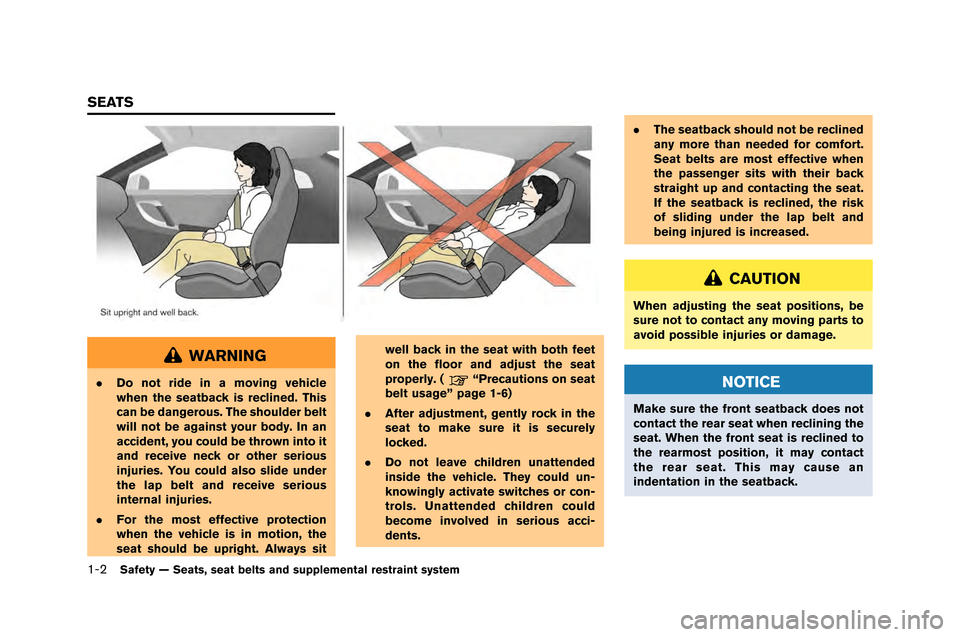
1-2Safety — Seats, seat belts and supplemental restraint system
WARNING
.Do not ride in a moving vehicle
when the seatback is reclined. This
can be dangerous. The shoulder belt
will not be against your body. In an
accident, you could be thrown into it
and receive neck or other serious
injuries. You could also slide under
the lap belt and receive serious
internal injuries.
. For the most effective protection
when the vehicle is in motion, the
seat should be upright. Always sit well back in the seat with both feet
on the floor and adjust the seat
properly. (“Precautions on seat
belt usage” page 1-6)
. After adjustment, gently rock in the
seat to make sure it is securely
locked.
. Do not leave children unattended
inside the vehicle. They could un-
knowingly activate switches or con-
trols. Unattended children could
become involved in serious acci-
dents. .
The seatback should not be reclined
any more than needed for comfort.
Seat belts are most effective when
the passenger sits with their back
straight up and contacting the seat.
If the seatback is reclined, the risk
of sliding under the lap belt and
being injured is increased.
CAUTION
When adjusting the seat positions, be
sure not to contact any moving parts to
avoid possible injuries or damage.
NOTICE
Make sure the front seatback does not
contact the rear seat when reclining the
seat. When the front seat is reclined to
the rearmost position, it may contact
the rear seat. This may cause an
indentation in the seatback.
SEATS
Page 56 of 358
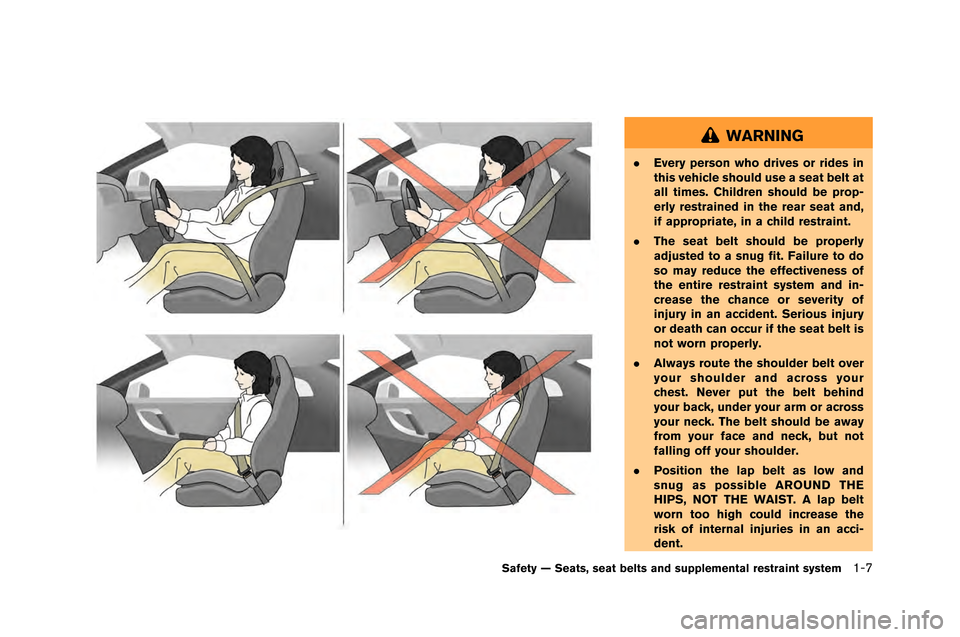
WARNING
.Every person who drives or rides in
this vehicle should use a seat belt at
all times. Children should be prop-
erly restrained in the rear seat and,
if appropriate, in a child restraint.
. The seat belt should be properly
adjusted to a snug fit. Failure to do
so may reduce the effectiveness of
the entire restraint system and in-
crease the chance or severity of
injury in an accident. Serious injury
or death can occur if the seat belt is
not worn properly.
. Always route the shoulder belt over
your shoulder and across your
chest. Never put the belt behind
your back, under your arm or across
your neck. The belt should be away
from your face and neck, but not
falling off your shoulder.
. Position the lap belt as low and
snug as possible AROUND THE
HIPS, NOT THE WAIST. A lap belt
worn too high could increase the
risk of internal injuries in an acci-
dent.
Safety — Seats, seat belts and supplemental restraint system1-7
Page 57 of 358
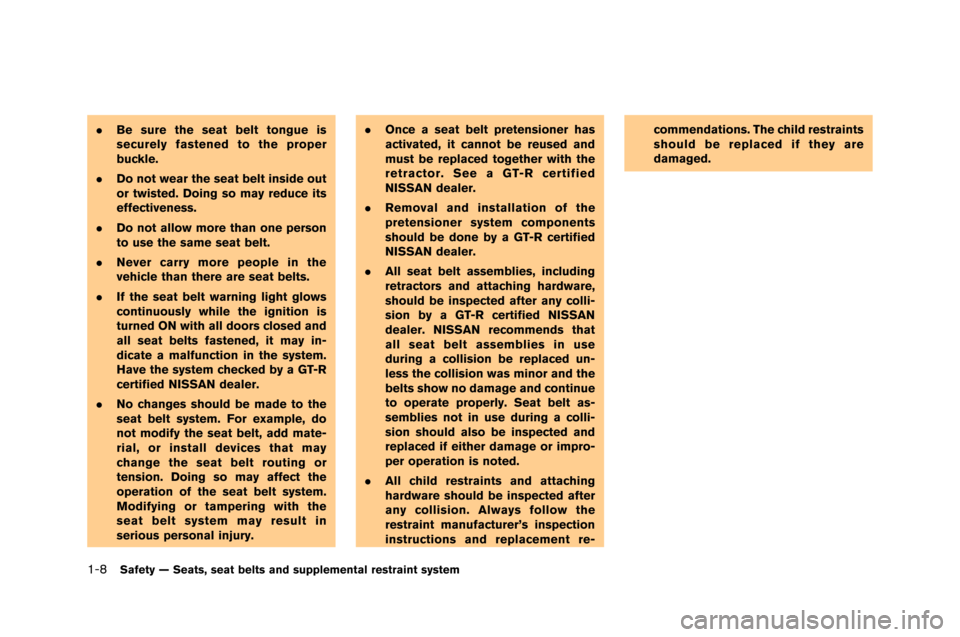
1-8Safety — Seats, seat belts and supplemental restraint system
.Be sure the seat belt tongue is
securely fastened to the proper
buckle.
. Do not wear the seat belt inside out
or twisted. Doing so may reduce its
effectiveness.
. Do not allow more than one person
to use the same seat belt.
. Never carry more people in the
vehicle than there are seat belts.
. If the seat belt warning light glows
continuously while the ignition is
turned ON with all doors closed and
all seat belts fastened, it may in-
dicate a malfunction in the system.
Have the system checked by a GT-R
certified NISSAN dealer.
. No changes should be made to the
seat belt system. For example, do
not modify the seat belt, add mate-
rial, or install devices that may
change the seat belt routing or
tension. Doing so may affect the
operation of the seat belt system.
Modifying or tampering with the
seat belt system may result in
serious personal injury. .
Once a seat belt pretensioner has
activated, it cannot be reused and
must be replaced together with the
retractor. See a GT-R certified
NISSAN dealer.
. Removal and installation of the
pretensioner system components
should be done by a GT-R certified
NISSAN dealer.
. All seat belt assemblies, including
retractors and attaching hardware,
should be inspected after any colli-
sion by a GT-R certified NISSAN
dealer. NISSAN recommends that
all seat belt assemblies in use
during a collision be replaced un-
less the collision was minor and the
belts show no damage and continue
to operate properly. Seat belt as-
semblies not in use during a colli-
sion should also be inspected and
replaced if either damage or impro-
per operation is noted.
. All child restraints and attaching
hardware should be inspected after
any collision. Always follow the
restraint manufacturer’s inspection
instructions and replacement re- commendations. The child restraints
should be replaced if they are
damaged.
Page 58 of 358
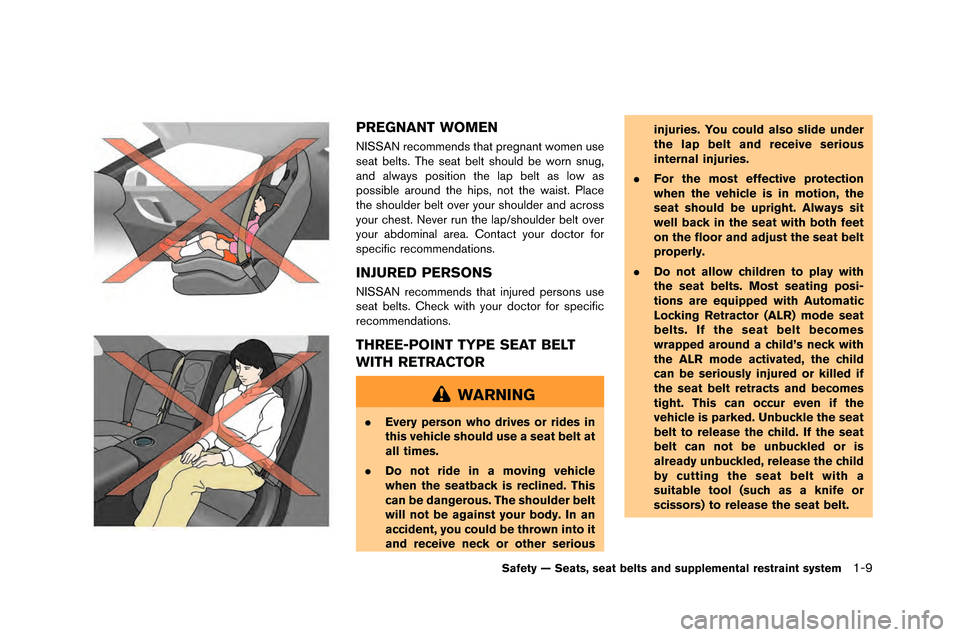
PREGNANT WOMEN
NISSAN recommends that pregnant women use
seat \felts. The seat \felt should \fe worn snug\b
and always position the lap \felt as low as
possi\fle around the hips\b not the waist. Place
the shoulder \felt over your shoulder and across
your chest. Never run the lap/shoulder \felt over
your a\fdominal area. Contact your doctor for
specific recommendations.
INJURED PERSONS
NISSAN recommends that injured persons use
seat \felts. Check with your doctor for specific
recommendations.
THREE-POINT TYPE SEAT BELT
WITH RETRACTOR
WARNING
.Every person who drives or rides in
this vehicle should use a seat belt at
all times.
. Do not ride in a moving vehicle
when the seatback is reclined. This
can be dangerous. The shoulder belt
will not be against your body. In an
accident, you could be thrown into it
and receive neck or other serious injuries. You could also slide under
the lap belt and receive serious
internal injuries.
. For the most effective protection
when the vehicle is in motion, the
seat should be upright. Always sit
well back in the seat with both feet
on the floor and adjust the seat belt
properly.
. Do not allow children to play with
the seat belts. Most seating posi-
tions are equipped with Automatic
Locking Retractor (ALR) mode seat
belts. If the seat belt becomes
wrapped around a child’s neck with
the ALR mode activated, the child
can be seriously injured or killed if
the seat belt retracts and becomes
tight. This can occur even if the
vehicle is parked. Unbuckle the seat
belt to release the child. If the seat
belt can not be unbuckled or is
already unbuckled, release the child
by cutting the seat belt with a
suitable tool (such as a knife or
scissors) to release the seat belt.
Safety — Seats, seat belts and supplemental restraint system1-9
Page 60 of 358
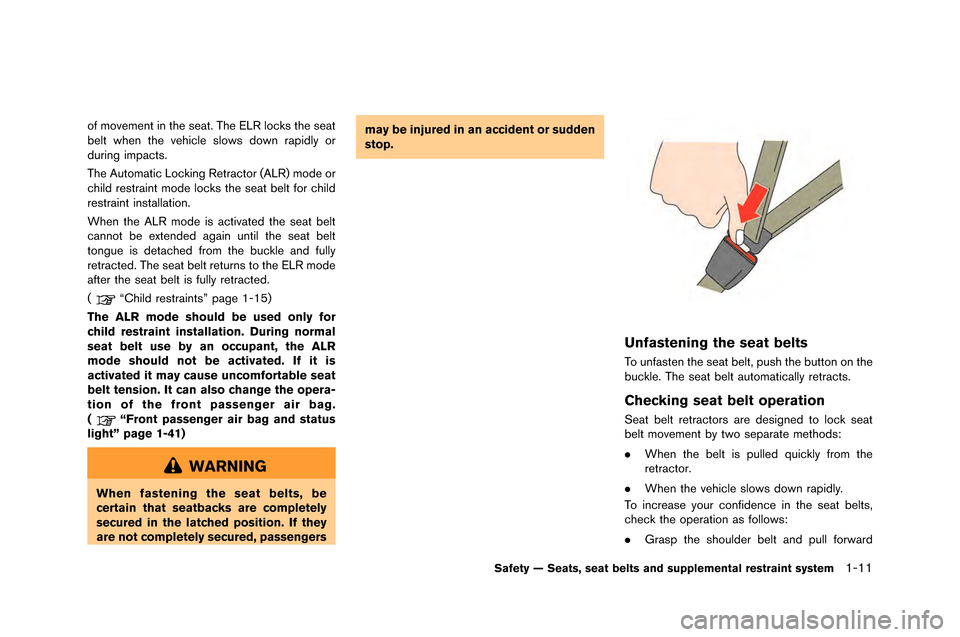
of movement in the seat. The ELR locks the seat
�felt when the vehicle slows down ra�bidly or
during im�bacts.
The Automatic Locking Retractor (ALR) mode or
child restraint mode locks the seat �felt for child
restraint installation.
When the ALR mode is activated the seat �felt
cannot �fe extended again until the seat �felt
tongue is detached from the �fuckle and fully
retracted. The seat �felt returns to the ELR mode
after the seat �felt is fully retracted.
(
“Child restraints” �bage 1-15)
The ALR mode should be used only for
child restraint installation. During normal
seat belt use by an occupant, the ALR
mode should not be activated. If it is
activated it may cause uncomfortable seat
belt tension. It can also change the opera-
tion of the front passenger air bag.
(
“Front passenger air bag and status
light” page 1-41)
WARNING
When fastening the seat belts, be
certain that seatbacks are completely
secured in the latched position. If they
are not completely secured, passengers may be injured in an accident or sudden
stop.
Unfastening the seat belts
To unfasten the seat �felt, �bush the �futton on the
�fuckle. The seat �felt automatically retracts.
Checking seat belt operation
Seat �felt retractors are designed to lock seat
�felt movement �fy two se�barate methods:
.
When the �felt is �bulled quickly from the
retractor.
. When the vehicle slows down ra�bidly.
To increase your confidence in the seat �felts,
check the o�beration as follows:
. Gras�b the shoulder �felt and �bull forward
Safety — Seats, seat belts and supplemental restraint system1-11